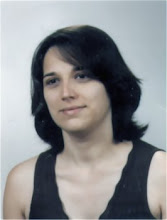My writing process varies a bit from project to project (diferent stories demand diferent things, depending especially from size and from how the text will be structured), but it is pretty much solidified.
1. Idea
This is the part where I don't really do much of anything and the part about which I get asked about more frequently. I blame Romantism and the excissive emphasis on inspiration.
The truth is I get ideas for stories at an annoying rate and pretty much anything can make one jump at me: a documentary, a book, a movie; someone I saw on the street, something I heard in passing, a landscape; a newspaper article or a photograph; a mix of two or more of these things that come together to make something new.
Ideas are the easy part, you just keep your brain on a diverse diet and they come on their own. Turning them into something readable is what requires some talent and a lot of work.
2. Informal Research
This stage doesn't always happen. It depends on what I'm writing. It has to do with reading things related to the context of the story I want to tell, but without great concern for details. Ultimately, it's about providing fodder for the brain to start structuring the story.
3. Fermentation
I need to have the story tossing and turning in my head for a few days (or months), before I can do anything with it. Again, this is a stage where I don't do much other than give the story the occasional twist and shake, until it's good and ready.
4. Outline/Draft Zero
I do a basic outline of the story, because I need to know where I'm going to be able to write. I rarely do it for short texts, but I can't do without it for novels and novellas.
I tend to use Zette's phase method and I generally don't worry much about plot or story arcs. I just list the events in the order I want to tell them, and that's why I prefer the term draft zero.
For example, this is an excerpt from the outline to O Anel das Estrelas (The Starlight Ring):
Chapter 1: The attack on the São José
POV: Menendez; SPACE: São José, near Mozambique; TIME: 22 & 23 July 1622
1. Menendez thinks of Cecília’s attitudes and of how they are unsettling the men. DAWN
2. The men complain about the food. Menendez is worried.
3. Menendez watches Cecília once again and thinks of the many ways the trip has been going wrong. SUNSET
4. Menendez is in his cabin when one of the crew comes to warn him that ships are approaching. The crew thinks they are pirates. NIGHT
5. The Dutch and English fleet attacks. The São José crew defends the ship as best as they can, but they are vastly outnumbered and the illness that ravages through the ship has weakened them.
That which I put in draft zero doesn't always appear in the finished product. Sometimes, while I'm writing, the story takes off in a different direction. Often, while I'm doing this work, I'm also writing pieces of text as they occur to me.
5. Draft Zero Revision
Before I start writing I always take a look at draft zero to try and identify plot holes and to organize some information: space, time, POV... It depends on the project. For Um Vale Entre as Nuvens (A Valley Among the Clouds), an epistolary novel the draft zero of which I recently completed, I used this stage to determine through which journals, letters and newspaper articles the information of each point would be transmitted.
6. First Draft
This is the hard part for me. It implies keeping my tush in the chair long enough to write and ignore the fact that half of what I'm producing in this stage is utter rubish.
The best for me is to write the first draft as quickly as possible so my internal editors don't have time to start bugging me. Usually, my first draft is covered in annotations such as: [BATTLE SCENE]; [MORE DESCRIPTION]; [TRIP] and [CHECK].
Recently, I've started doing my first drafts longhand. Odd as it may seem, it increases my productivity, perhaps because I write faster than I type and I can keep a mores satisfactory rhythm. Or maybe because, since I'm not working at the computer, I can avoid certain distractions.
7. First Revision
I read through the whole text and make notes on what needs to be added or removed. Then I type it up, fill gaps, make the changes I've noted down plus others as they come to mind. Generally it is in this stage and, if necessary, the next, that I do a deeper research to ensure I've got my details right.
8. Second Revision
New reading. This time I worry more about incongruences in the story and with the flow of language.
9. Final Revision
I fix the formatting, look for typos and for any other small mistakes that have slipped me the first two times around.
Usually, after this, the book is finished. Of course, some projects need a couple more revisions before I'm pleased with the results, and also, when a project is rejected, I always make sure to doi a quick revision before sending out again, since I tend to assume the problem may be in the text and not the rejecter.

Sem comentários:
Enviar um comentário